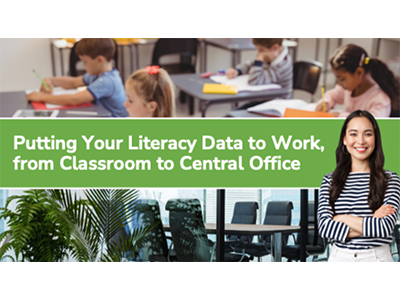Linking Learning to Literacy Instruction, from Central Office to Classroom
Watch the RecordingListen to the Podcast
Improvements in students’ reading achievement require continued learning not just by the students, but also by their educators. As discussed during the edLeader Panel “Putting Your Literacy Data to Work, from Classroom to Central Office,” all the adults involved in the literacy development process, from administrators to coaches, teachers, and paraprofessionals, need to continue learning from the research, each other, and their students.
Panelists included District Literacy Coach Andrea Williams, Principal Lorraine Zapata, and Leslie Zoroya, a Reading/Language Arts Project Director for the Los Angeles County Office of Education (LACOE). Zoroya explained that her office works with 81 school districts, which are responsible for educating 1.6 million students, and LACOE obtained a multi-million dollar grant to improve reading instruction in districts such as the Lancaster School District, which is located in the northern part of Los Angeles County.
Lancaster was chosen in part because of its low reading scores, but also because the district leaders and educators had a shared commitment to improving the outcomes for their students. Lancaster is a Title I district in which close to 80% of the students are socio-economically disadvantaged, with 58% identified as Hispanic, 27% African American, and 8% White. Almost 15% of the students are classified as English learners.
Literacy Learning at the District Level
As a district literacy coach, Williams saw the district data as a key starting point in the learning process because it showed that the way students were being taught was not okay, and a new research-based approach was needed. To implement that approach, training was required for all the educators directly involved in literacy development, and for the administrators and coaches who would help the teachers provide more effective instruction.
Support for small-group instruction was recognized as a crucial part of meeting students’ specific literacy needs, and identifying those needs required not only training but also improved assessment data. Students were being assessed three times a year, and more specific data was needed to determine exactly what individual students needed to learn. Then, the educators had to learn how to meet those instructional needs.
In order to support the training and learning process across the district, professional learning communities (PLCs) were given time every Monday to examine and discuss student data. In addition to identifying what wasn’t working, there was also a focus on where growth was occurring and why. An emphasis was placed on providing grace and safety for educators who did not know what to do, so they could be open about learning how to improve their instruction.
The district’s literacy coaches supported this learning process through pop-ins and data dives, as well as a focus on systemic thinking in which every aspect of the literacy development process was aligned. Strengths-based reflection forms were also used to support a shift from thinking “we can’t do this” to having teachers watch an educator, coach, or administrator actually do it in a classroom, and then having a group debrief afterward.
Literacy Learning at the School Level
For Zapata, building the capacities needed to provide systematic instruction was a top priority, as was having a master schedule that reflected the educators’ needs and goals. This included having the educators do their data analysis, literacy learning, and debriefing during the school day when they had the energy and focus that would optimize their learning experiences.
Knowing that students’ assessment data was crucial, Zapata’s school developed an assessment team that did the first round of assessments themselves. The second round was split with classroom teachers, who did the third round on their own unless they asked for help. Rather than relying solely on test scores, the assessment of students included artifacts and other evidence of learning.
Zapata’s guidance and support for the process included walk-throughs with a calibrated tool, and providing actionable feedback that supported goal setting and reasonable implementation of new practices. In addition to participating in schoolwide training, teachers were encouraged to talk with and learn from each other as part of a “culture of learning,” which enabled them to develop the knowledge and skills that would help their students succeed.
Reflecting on the biggest challenges in the learning and instructional improvement process, Zoroya at the Los Angeles County Office of Education mentioned time as the most difficult constraint, because there simply wasn’t enough of it to accommodate everything the educators needed to do, learn, practice, and reflect on.
For Zapata, “chronic attendance” was the biggest challenge, because so many absences were due to barriers that the students couldn’t control. As she pointed out, students who missed just two or three phonics lessons could develop literacy gaps and fall behind, so educators needed to be able to identify and support those students, while school and district officials worked on removing the barriers and building parent support.
Learn more about this edWeb broadcast, Putting Your Literacy Data to Work, from Classroom to Central Office, sponsored by Learning Without Tears.
Watch the RecordingListen to the Podcast
Join the Community
Building Foundational Literacy Skills is a free professional learning community designed to help teachers make Pre-K–5 readiness, reading, handwriting, and keyboarding easy and fun for all.

Article by Robert Low, based on this edLeader Panel.




Comments are closed.